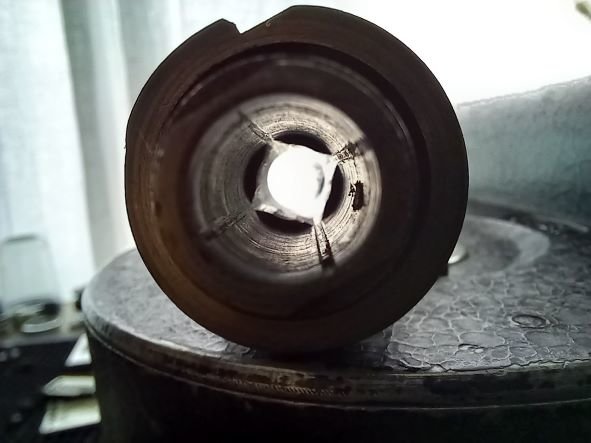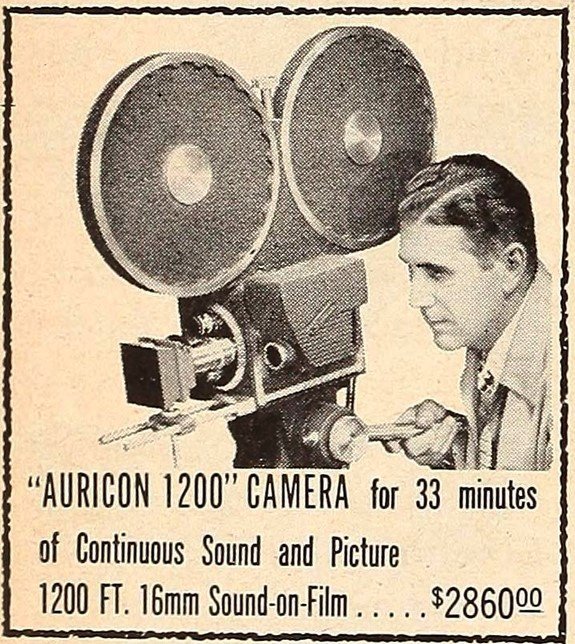-
Posts
2,414 -
Joined
-
Last visited
Everything posted by Simon Wyss
-
There’s that image with the German Wikipedia page for the Bell & Howell Company: I took it in 2006. It’s from a set of CIRCUS, a silent picture made then. Olympus Pen-F, Gigabitfilm 40, proprietary developer from the Gigabitfilm enterprise. Here is the full image: The negative size is 18 × 24 mm. I scanned an enlargement on RC photo paper, a little smaller than 18 × 24 cm at 300 DPI. Another cutout from the same enlargement, scanned at 600 DPI: This is a tad bigger than three by three millimetres of the negative. One can see well the scale of the footage counter and the one for the shutter times. There is still a lot more on the negative. The enlargement was not made with special care. I don’t know what you’re talking about.
- 6 replies
-
- 1
-

-
- film v digital
- candid photography
- (and 3 more)
-
There is no obligation to use Kern lenses with Paillard-Bolex cameras. D-mount optics were also made by Leitz, Laack, Berthiot, Angénieux, Taylor Taylor & Hobson, ILEX, Wollensak, Elgeet, Kodak (yes), Gundlach, Zeika, Ichizuka, Nikon, Arco, Soligor, Simpson, Chinon, Sun, Hermagis, Zeiss, Steinheil, Dallmeyer, Rodenstock, Bausch & Lomb, Meyer, Schneider, Isco, Astro, and others.
-
Alright, M 28 then The Yvar 13 mm, f/1.9 is a triplet. There must be something shifted between text and images. The lens shown next to The Pizar 12.5mm (½") F:1.9 is the Pizar 26 mm, f/1.9 for 16-mm. film. The Pizar 12,5 mm, f/1.9 is a triplet, too.
-
The Switar 36 mm, f/1.8, is a five-glass lens. Positive, cemented achromat (flat common surface), thick negative, diaphragm, positive The filter thread is the M 33,5 × 0,5 mm.
-

C-mount lens to D-mount camera adapter?
Simon Wyss replied to Aapo Lettinen's topic in Lenses & Lens Accessories
ELGEET -
The absolute size is reflected in the price. Optical glass costs more than window float pane and bigger mechanical parts are pricier, too. Medium relative aperture lenses have smaller elements compared to speedy ones which again leads to cheaper products. Mass produced amateur optics are cheaper than professional volumes but not necessarily worse. If you can handle an Animar 26 mm, f/1.9 you get beautiful images. As a keen cinematographer you know what lens you want, a triplet, a four-glass lens, a six-elements design, opening of f/4.5, opening f/1.8, and so on. Depending on the type of camera in question, a heavy tripod Mitchell 16 Professional, a hand-held GIC 16 or a Beaulieu R 16, you gather luxurious glass or compact and lightweight lenses, respectively. One thing is important, the mechanical quality of diaphragms. Regardless of size some makes hide second-class stuff. It comes down to single products and series whether the diaphragm is robust or weakish. Unfortunately.
-
No, I have never seen a Ciné-Kodak Economy with an electric motor but the US government grasped as much of cine material as it could from 1942 on. Eastman-Kodak seems to have complied with enquiries. No idea about tension. Spiral cord is younger, 1960s.
-
Army-Navy code
-

Schneider-Kreuznach Tele-Xenar Differences
Simon Wyss replied to Zach Moore's topic in Lenses & Lens Accessories
Pardon me, wanted to say barrels. Casings? -
There are mirror shutter reflex-finder cameras for Double-Eight film. The first one was the ERCSAM Camex 8 Reflex, presented on May 6th, 1955. In 1956 came the Armor 8 C (double-prism block like Paillard-Bolex but slid in and out before a take). Then the Nizo Heliomatic 8 Reflex in 1957, the Beaulieu Reflex 8, 1959, and the Pentaflex 8 in 1960.
-

Schneider-Kreuznach Tele-Xenar Differences
Simon Wyss replied to Zach Moore's topic in Lenses & Lens Accessories
They’re of the same five-elements design. Only the mounts are different. -
The original pins were made by Spirol. A couple years ago I inquired with Spirol about manufacture of these. The answer was minimum order 200,000.
-
Fomapan Reversal was introduced in 1950, named R21 initially. Eastman-Kodak made Panatomic-X available in 16-mm. and Double-Eight in 1947, ASA 32. Super-X and -XX came out before the war, Plus-X negative in 1938. You still had the early Kodak Safety Ciné film which was orthochromatic reversible and Kodak Panchromatic Safety reversible. Bauchet introduced a Super Panchro reversal in 1939. Gevaert stocks since 1932. Schleussner and Mimosa since 1936. In Britain there was available Selo ortho. reversal in 9.5-mm. in the twenties until 1928. Ilford Pan F from 1956 on. Konica made 16-mm. film from 1931 on, Double-Eight stock since 1933. The Kodak reversal stocks on grey and blue base began being used from 1954 on. Developers used to be hydroquinone-metol formulae. Newsreels were 35-mm. with 16-mm. exceptions rather than the rule. Blow-up and reduction printing was done since the early 1930s. You had a clear-cut distinction between professional commercial cinema which used standard film and the substandard amateur or, to some extent, scientific cinema. Experimental cinema happened on standard film. Artists used the spring driven Sept by Debrie, ICA Kinamo, Cinégraphe Bol, Bell & Howell Eyemo, De Vry. 8-mm. was considered a purely home movie format. Kodachrome became available in 16 and Double-Eight in 1936. The finer-grained Kodachrome II came out in 1961. Why emulate something that won’t be recognized as original? Will you project? Will you use non-bloomed lenses on camera and projector? Do you have an idea of the light seen by the public, incandescent, carbon arc? Do you want your images go lost in the sea of LCD displays like all others? Cinema is something apart from computers and data. Films can be projected without electricity.
-
The 1962 NS P 400 has a pair of fixed pilot pins like the Bell & Howell 2709 or an early Mitchell, closer to the Mitchell AA movement which also pivots around a shaft above the gate. https://cinematography.com/index.php?/forums/topic/72258-mystery-camera/ https://archive.org/details/americancinemato43unse/page/38/mode/2up?view=theater&q=Newman
-
New generations grow up to replace us sooner or later. Who cares about terminology? Very few
-
I find the G overengineered, impractical, and geometrically absurd. Although of fine workmanship the mechanism is heavy and noisy. Ventilation not so good. The film canal is of such design that you can remove the pressure plate but the other half is not accessible. You need to wipe through with bottle brushes. You can’t inspect the corners. The long canal is detrimental for splices that are only little askew. The positioning offset, i. e. the distance between the transport claw and the optical axis, is too long, far from any camera’s and printer’s one. For best image steadiness the geometries of the devices should match. Your camera positions in the perforation hole +3. Else the lens receptacle diameter is obsolete. There are better silent projectors available for less money.
-

Best C-mount Prime Lenses for Eclair NPR
Simon Wyss replied to Benjamin Bosko's topic in Lenses & Lens Accessories
Berthiot Cinor might suit a French camera. They’re totally neglected and therefore cheaply available. The seven-elements f/1.5 Cinor from 1935 will surprise you. Then you have Kinoptik, expensive, Hermagis, and Angénieux. If you want to investigate American lenses, the brands are Bausch & Lomb, Wollensak, ILEX, Graf, Gundlach, Kodak, Elgeet, Century, Zoomar, Veydra. Of course, old-timers need to be serviced.- 2 replies
-
- eclair npr
- prime lenses
-
(and 1 more)
Tagged with:
-
Caro Daniele, do us a favour and try to hold yourself back for a moment each time before you send off, only as briefly As the Day Shines. Auricon were professional equipment. Amateurs, if they were out for a synch sound film, would record audio on magnetic tape rather than optically. In 1957 was already recession, I can google that within a minute. The money wasn’t everywhere at hand. But thanks anyway for the lush scan
-
Why not C-mount optics? What makes a new generation abhor from the original lenses? Optically they’re much better than any stills photo lens you can pick because they were calculated and made for the format.
-
That’s why, you are giving the answer. Had Dr. Bolex done his work properly you could use the critical focuser. A crisp, clean view of the scene is possible by which you can choose the field of sharpness at will. I know how much work it takes to clean an entire H.
-
That tells everything. It had to be a Paillard-Bolex camera but you don’t let live the lenses you have. The camera is made for C-mount optics. As Dom said, the adapter may be inferior or, my presumption, the focusing prism not seated correctly. I have encountered this many times with those cameras. CLA can mean plenty of things. The A stands for adjustment and I doubt that the focusing finder got worked on. I even doubt that the mechanism of your camera was disassembled and gone through thoroughly. Else the stills photo lens by its weight or you yourself may pull on the turret plate manipulating it, lift it off slightly, enough to make focusing impossible.
-
Since you persist: no. Since you didn’t respect what I wrote about the one-inch and the two-inch Ivotal I can’t participate in this discussion any longer.
-
ECCE HOMO No warm colour shift, that’s publicity talk. Depth of field is particular to a single design. Contrast depends on blooming and cleanliness. Sharpness of a figure is the focusing you do with the aid of microprisms, a split-image device, a superposition rangefinder, a ground glass surface or via comparison of an air view to a hair cross or similar. Now I have the entire forum against me. Apodictic someone needs to be in order to sweep away the mental fuzz wavering around today. Non solo in Italia. Tripod, serviced camera, black-and-white print stock, that’s how you should start. Observe light and shadows on the various things.
-

how to remove the viewfinder (bolex h16 reflex)
Simon Wyss replied to Richardson Leao's topic in Bolex
Yes, can be corroded. May take quite some force.




